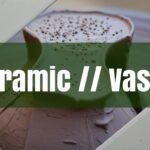Creating a ceramic vase by hand is a wonderfully tactile and rewarding experience. From choosing the right clay to the final firing, each step offers a chance to imprint your personal touch on a functional piece of art. Let’s explore how you can bring your vision to life, transforming a simple lump of clay into a beautiful ceramic vase.
The first step in crafting your ceramic vase is selecting the right clay. For beginners, stoneware is often the best choice due to its durability and workability. Stoneware clays fire at high temperatures, typically between 1,200°C and 1,300°C (2,192°F to 2,372°F), resulting in a strong, non-porous vase perfect for holding water. Stoneware is known for its durability and ease of use. Porcelain, known for its delicate and refined appearance, is another option, but it’s more challenging to work with due to its lower plasticity. Earthenware is easier to shape but requires proper glazing to be watertight, as it’s more porous after firing. You can read more about Earthenware on Wikipedia.
Choosing the right clay is essential for the success of your ceramic vase. Stoneware is ideal for beginners, while porcelain offers a refined look but requires more skill.
Once you’ve chosen your clay, gather your tools. For hand-building techniques like coil building, slab construction, or pinching, you’ll need a variety of tools to shape, join, and refine your vase. Essential tools include a wire clay cutter for slicing clay, a needle tool for scoring surfaces before joining, and a variety of wooden or metal ribs for shaping and smoothing. You’ll also need slip, a mixture of clay and water, to bond pieces together securely. Depending on your chosen technique, you might need a rolling pin or slab roller for creating even slabs, or a coil extruder for uniform coils. To learn more about this, you can read a guide to hand-building pottery. With your clay and tools at the ready, you can use a number of different hand-building methods like pinching, coiling, or slab building, to create your vase.
- Wire clay cutter
- Needle tool
- Wooden or metal ribs
- Slip
Make sure to gather all necessary tools before starting.
After you’ve built your vase, the next crucial step is drying it properly to prevent cracking and warping. Gradual and controlled drying is key to ensuring even moisture evaporation. Avoid direct airflow and extreme temperatures, which can cause uneven drying. Covering the vase with plastic, creating a tent-like structure, or using a damp box can help slow down the drying process. More information on this can be found at ceramicartsnetwork.org. Rotate and invert the vase periodically to ensure all parts dry at a consistent rate. The drying time will vary depending on the size and thickness of your vase, so patience is essential to avoid cracks. After the vase is bone-dry, it’s time for the first firing, known as bisque firing. This is typically done at cone 04, around 1,950°F (1,066°C), to harden the clay for glazing. More information on firing schedules is avaliable at americanceramics.com.
Drying the vase slowly and evenly is crucial to prevent cracks and warping. Patience is key!
Glazing is what really brings your vase to life, adding color, texture, and functionality. There are several glazing techniques to choose from, each offering different effects. Dipping provides a uniform coating, while brushing allows for precise control and intricate designs. Find out more about glazing techniques for beginner potters. Spraying is efficient for large or complex pieces, creating smooth finishes. After glazing, the final firing vitrifies the clay and matures the glaze, creating a durable and visually stunning piece. For stoneware, this is typically done at cone 5 or 6, around 2,160°F to 2,192°F (1,182°C to 1,200°C). The firing schedule involves gradually increasing the temperature, soaking at the peak temperature, and then slowly cooling to enhance glaze effects and reduce defects. With careful attention to each step, you’ll create a ceramic vase that’s not only functional but also a beautiful expression of your creativity.





